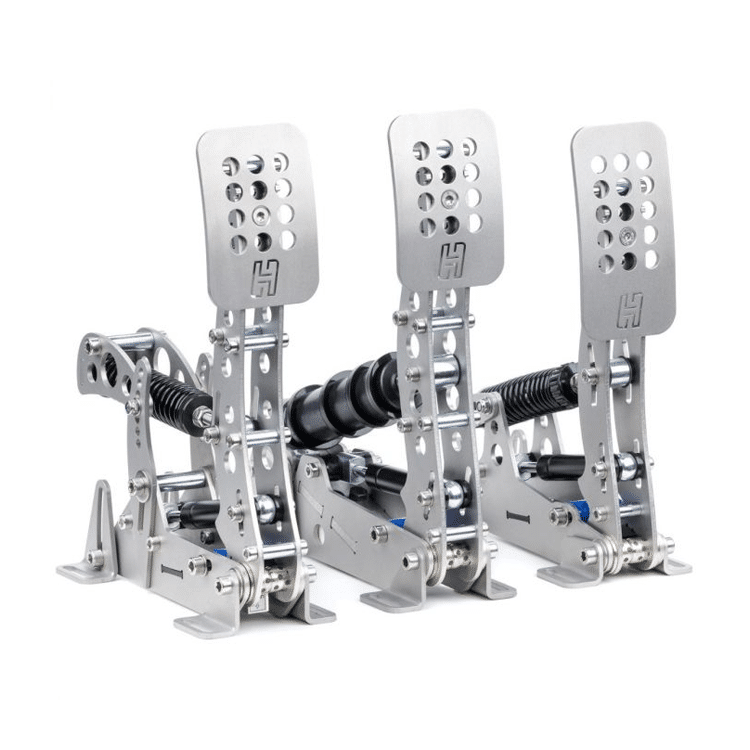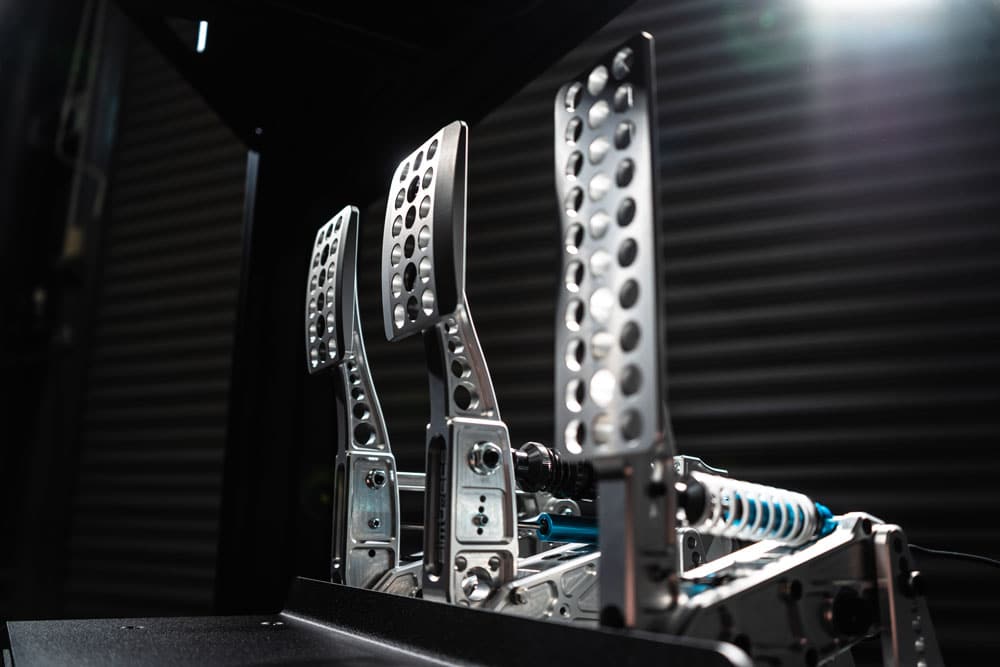Sim racing pedals play a crucial role in the overall driving experience, impacting performance and immersion. Upgrading to a quality set of sim pedals can significantly enhance braking accuracy, pedal feel, and customisation options, providing a more realistic and enjoyable sim racing experience for both new players and seasoned sim racers.
The Benefits Of Upgrading To A Quality Set Of Sim Pedals
Investing in a high-quality set of sim racing pedals offers several advantages that can significantly elevate the overall racing experience:
- Improved braking accuracy through load cell technology: Load cells measure the amount of force applied to the brake pedal, resulting in more precise and consistent braking performance. This technology outperforms traditional potentiometer-based pedals, which rely on pedal travel distance to determine brake input.
- Enhanced pedal feel and force feedback for realistic driving sensations: Quality sim pedals feature advanced mechanisms that provide a more authentic and immersive feel, closely replicating the sensations experienced in real-world racing. This includes realistic resistance and force feedback, allowing racers to better gauge their braking and throttle inputs.
- Increased adjustability for customisation and optimised ergonomics: High-end sim pedals often offer a wide range of adjustability options, enabling users to tailor the pedals to their specific driving preferences and style.
- Better durability and build quality for long-term use: Quality sim racing pedals are typically constructed from robust materials, such as aluminium and steel, ensuring durability and longevity. This ensures that the pedals can withstand the rigours of sim racing and deliver consistent performance over time.
Overall, upgrading to a premium set of sim racing pedals can significantly enhance the driving experience, providing greater precision, immersion, and customisation options for both novice and experienced sim racers.

Adjustability and customisation options in quality sim pedals
Adjustability is an essential feature in high-quality sim racing pedals, as it caters to the diverse driving preferences and styles of sim racers. Premium sim pedal sets, like the Heusinkveld Sim Pedals, offer a wide range of customisation options that allow users to tailor their pedals to suit individual needs and replicate real-world race cars.
Some common adjustment options found in high-end sim pedals include:
- Pedal angle: Adjusting the angle of the pedal face to match the user’s preferred foot position.
- Travel: Modifying the distance the pedal moves to achieve optimal input sensitivity and control.
- Resistance: Altering the force required to actuate the pedal, providing a more realistic and immersive feel.
- Spacing: Changing the distance between the pedals to accommodate different foot sizes and driving styles.
To tailor pedal settings to individual needs, users should consider their personal driving preferences, the type of racing they participate in, and any specific requirements of their real-world race cars. By investing time in adjusting and optimising sim pedals, racers can significantly enhance their driving experience and performance in the virtual racing world.
Hydraulic sim racing pedals
Hydraulic sim racing pedals offer an advanced and realistic alternative to load cell and potentiometer-based pedals, providing an even more immersive driving experience. The key difference between hydraulic pedals and other types is the incorporation of a hydraulic system, which closely mimics the feel and operation of real-world race car pedals.
One of the primary advantages of hydraulic pedals is their ability to deliver progressive resistance, which allows for more accurate and nuanced braking and throttle inputs. This is particularly important in sim racing, where precision and control are critical factors in achieving optimal lap times and performance.
Furthermore, hydraulic sim racing pedals typically feature high-quality construction and materials, ensuring durability and longevity. Although they may come at a higher price point compared to the load cell and potentiometer-based pedals, hydraulic pedals are a worthwhile investment for those seeking the most realistic and responsive sim racing experience.

Pedal base mounting and avoiding flex
A sturdy pedal base is essential for achieving optimal performance in sim racing, as it provides a stable foundation for the pedals and ensures consistent and accurate inputs. When considering an upgrade to a high-quality set of sim racing pedals, it’s crucial to also examine the pedal base mounting solutions and strategies to minimise flex.
Quality sim pedals often come with robust mounting solutions that cater to a variety of sim racing rigs and setups. These mounting options can range from simple clamps to more advanced, adjustable brackets and plates. It’s essential to choose a mounting solution that best suits your individual rig and preferences, ensuring a secure and stable connection between the pedals and the base.
Minimising flex in the pedal base is vital for maintaining a stable and consistent driving experience. Flex can lead to inaccuracies in pedal inputs and detract from the overall immersion of sim racing. To reduce flex, consider the following tips:
- Ensure the pedal base is securely fastened to the rig, eliminating any loose connections or wobbling components.
- Choose a mounting solution made from sturdy materials, such as aluminium or steel, to provide a rigid and durable foundation.
- Opt for a pedal base with adjustable tension, allowing you to fine-tune the rigidity and eliminate any unwanted flex.
By investing in a quality set of sim racing pedals and implementing proper pedal base mounting strategies, sim racers can significantly enhance their driving experience, ensuring precise and consistent pedal inputs throughout every race.
Future updates and resale value
When investing in a quality set of sim racing pedals, you should consider factors that may impact their long-term value. Two critical aspects to keep in mind are future compatibility and upgrades, as well as the potential resale value of the pedals.
Considering future compatibility and upgrades is important because sim racing technology is continuously evolving. As new hardware and software solutions emerge, users may want to upgrade their sim racing setup to stay competitive and enjoy an enhanced driving experience. It’s essential to choose a set of pedals that are designed with future compatibility in mind, enabling seamless integration with new technology and systems. This approach will help to maximise the long-term value and enjoyment of the pedals.
Choose The Right Pedals For You
In conclusion, a quality set of sim pedals can make a significant difference in a sim racing setup. Upgrading to high-quality sim racing pedals can lead to improved braking accuracy, enhanced pedal feel, and increased adjustability, all of which contribute to a more immersive and enjoyable driving experience for both new players and experienced sim racers. We encourage readers to invest in high-quality sim racing pedals to elevate their performance and enjoyment in the virtual racing world.
